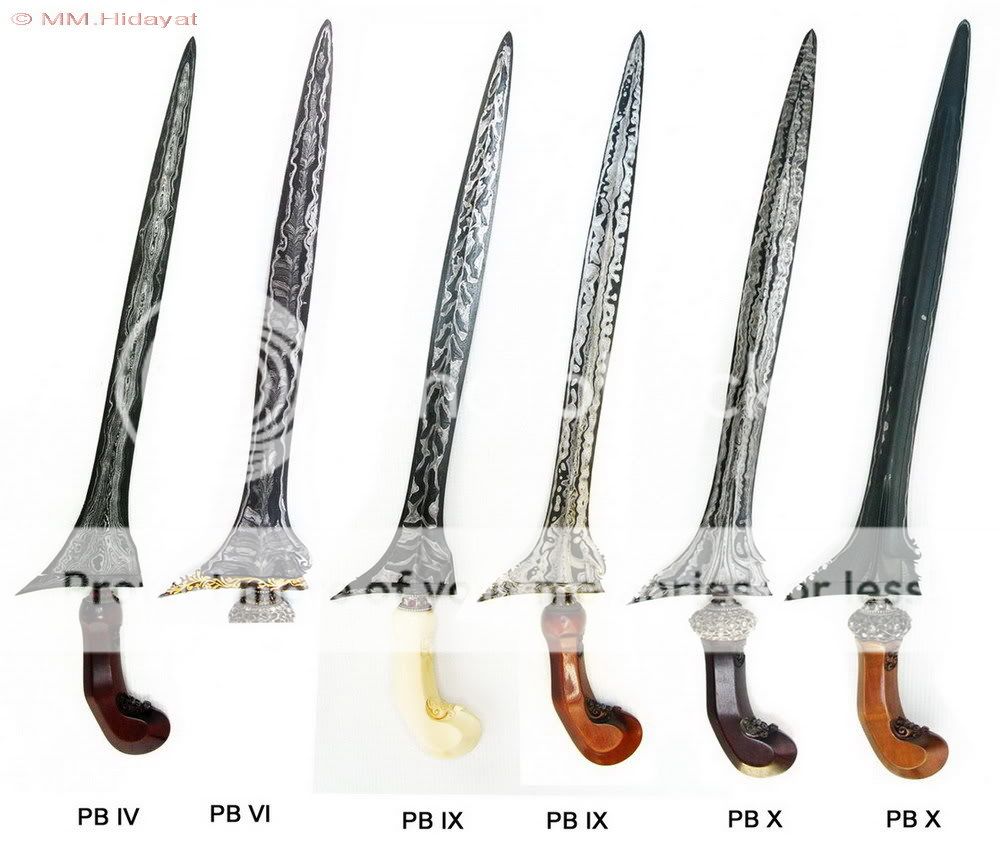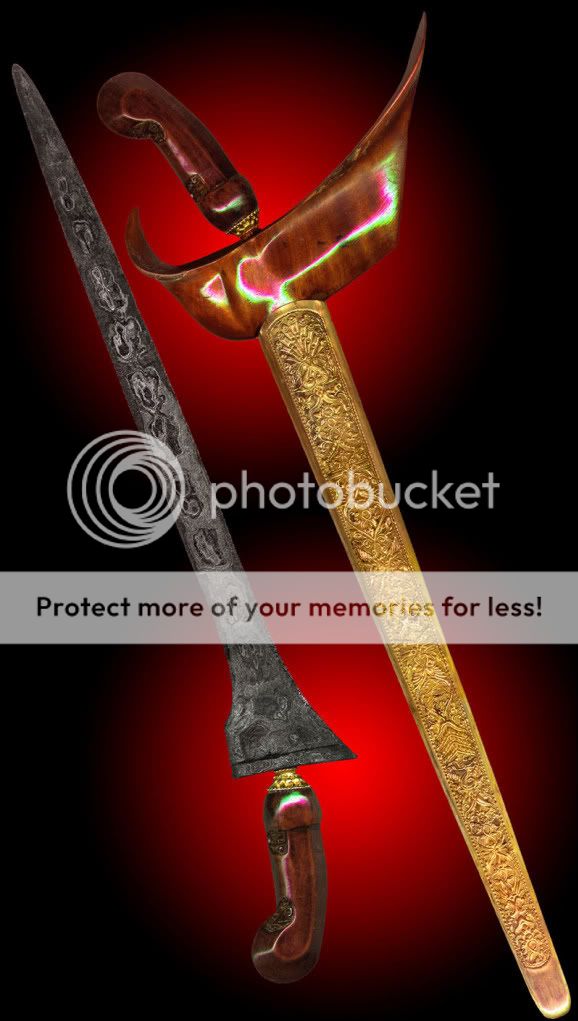Keris is a typical Indonesian stabbing weapon, or perhaps more
accurately Archipelago. Based on ancient documents, the keris in preliminary form has
been used since the 9th century. Strong likelihood that the keris has been used before
that time. The use of the keris itself scattered in clumps community Malays. At present, the keris commonly known in the
area of Indonesia (especially in the areas of Java, Madura,Bali /Lombok, Sumatra, part of Borneo, and some of Sulawesi),Malaysia, Brunei, Thailand, and Philippines (particularly in the Mindanaoregion). In Mindanao , the form of weapon which is also called the keris is not much resemblance
but also a stabbing weapon.
Keris has a variety of forms, for example, there is a winding blade
(always in odd count) and some are straight bladed. Javanese people assume different
forms have different effects esoteri. Besides being used as a weapon, the keris is also often
considered to have supernatural powers. This weapon is often mentioned in many traditional
legends, such as keris Mpu Gandring in legend of Ken Arok and Ken Dedes. The procedure to use keris is different in each
region. In areas such asJavanese and Sundanese, the keris is placed in the back of the waist in peacetime but is placed in
front in the war. Meanwhile, in Sumatra,Borneo , Malaysia , Brunei and the Philippines West Java cleaver. Keris distinguished from
other stabbing weapons primarily from the blade. Keris is not made from a
single metal casted but a mixture of various metal layers. As a result of this manufacturing technique, the keris has a specificity of fame on the blade.
Keris parts
Some terms in this section is taken from the Javanese tradition, simply because the reference is available. Some tosan aji experts classify keris as stabbing weapons, so
the main part of a keris is wilah(bar) or in lay language term is like a knife
blade. But because the keris has other fittings, i.e. the sheath (sarong) and the
handle of the keris, or carving, then the unity of all the trimmings is called
a keris.
Handles or upstream of Keris
Handle of the keris (Javanese: gaman) is a variety of
motives, to keris Bali which resembles a statue of the god, the statue pedande, raksaka
statues, sculptures of dancers, sage, forest, and some carved with gold and
precious stones. Celebes keris handles describe
seabird. It was a symbol of the most professional people who are sailors, while
the bird is a symbol of the world for safety. Like a bird's head motif is also
used in the Riau Linga keris, and for other areas
as the tosan aji development centers such as Aceh, Bangkinang (Riau), Palembang, Sambas, Kutai, Bugis, Luwu, Java, Madura and Sulu, has a different
symbol. In addition, the materials used were derived from various materials
such as ivory, bone, metal, and most of the wood. Handle of Javanese keris, consist of Sirah Wingking (backhead), Jiling,Cigir, Cetek, Bathuk (forehead), Weteng and Bungkul (cauliflower).
Sheaths or Sarong
Sheaths (Javanese:warangka), or sarong keris (Banjar Language:
kumpang), is a component of the kerishas a specific function, especially in the social life of Javanese society, at least because
this is the visible part directly. Sheaths which first made of wood (which
generally is teak, sandalwood, Timoho, and kemuning). Afterward, the warangka function changed,
become a reflection of social status for its users. The top or Ladrang-Gayaman often replaced with
ivory.
Broadly speaking there are two forms of the sheath, the sheath
type Ladrang consisting of the parts:angkup (tweezers), lata, janggut (beard), gandek, godong (shaped like a leaf),
yoke, cangkring and ri. And other types of warangka Gayaman (gandon) which
parts similar to warangka Ladrang but there is no
tweezers, godong, and gandek. Rules in using this warangka type has been
determined, though not absolute. Ladrang Warangka used for official
ceremonies, say to the king, the other court official event (the coronation,
royal appointments, marriages, etc.) with the intention of respect. The
procedure is to use thekeris tucked in the folds of
axle belt (stagen) on the back of the waist (including the consideration
for the safety of the king). While Gayaman wrangka used for daily
necessities, and the keris placed on the front (near the waist) or at the back (waist
rear). In a war, which is used is warangka Gayaman keris, consideration is the practical side and concise, because it allows warangka Gayaman more quickly and easily
move, because the simpler form. Ladrang and Gayaman is a pattern-form of warangka, and the main part according warangka function is part of a
long-shaped bottom (along wilah keris) called gandar (the yoke) or antupan, then the function is to wrap the axle wilah (bar) and usually
made of wood (considered to not damage the fabric wilah alloy). Because the
function to wrap the axle, then the function of beauty is not given priority.
Outside the gandar itself, cylindrical shell cover called pendok is used. Pendok (shell layer) is
usually very beautiful carved, made of brass, suasa (a mixture of copper gold), silver, and gold. For areas outside
of Java (among the Bugis kings, Goa, Palembang , Riau, Bali ) the pendok made of gold, along
with decorations such as embroidery string of gold and diamond flower. For Java keris, according pendok form there are three kinds, namely:
(1) pendok bunton flat-shaped shell with
no fissure on the sides,
(2) pendok blewah (blengah) split
extends to one end so that the axle will be seen, and
(3) pendok topengan which is the fissure
located only in the middle. When viewed from the jewelry, there are two kinds of pendok, carved and plain (no carving).
Wilah
Wilah or wilahan is the main part of a keris, and also consists of certain parts that are not the same for
every wilahan, which is usually
called dapur (there are dozens dapur). For example, to mention dapur Jangkung Mayang, Jaka Lola, Pinarak, Jamang murub, Bunggkul (cauliflower),Kebo
tedan, Pudak sitegal, etc. In the bottom
end of wilahan there part called pesi, which is the lower end of a keris. This section is keris part that come into
curved handle. This pesi length between 5 cm to 7 cm, with a cross-section of about 5 mm
to 10 mm long round like a pencil. In the area of East Java, called paksi, in Riau is the puting, while for the Sarawak, Brunei
and Malaysia
Luk
Luk, is a part of the winding of wilah, and views from the shape of the keris can be divided into two
major groups, namely the straight keris blade and the winding or luk. One simple way to calculate luk at bar, starting from
the base to the tip of the keris, calculated from the
convex side and performed on the two-cross the other side (right-left), then
the last number is the number of luk on the blade and the
number is always odd (odd) and was never even number. The smallest is three (3)
and most are luk thirteen (13). If there are a number of luk more than thirteen,
usually called keris kalawija, unusual keris.
Tangguh Keris
Keris known in the field of
so-called tangguh grouping that could mean a period of manufacture orproduction style. This is similar
to Java dance, for example, with dance styles of Yogyakarta andSurakarta.
Understanding the tangguh will help identify the physical characteristics of a keris. Sometangguh commonly known:
1.
tangguh Majapahit
2.
tangguh Pajajaran
3.
tangguh Mataram
4.
tangguh Yogyakarta
5.
tangguh Surakarta
           |


